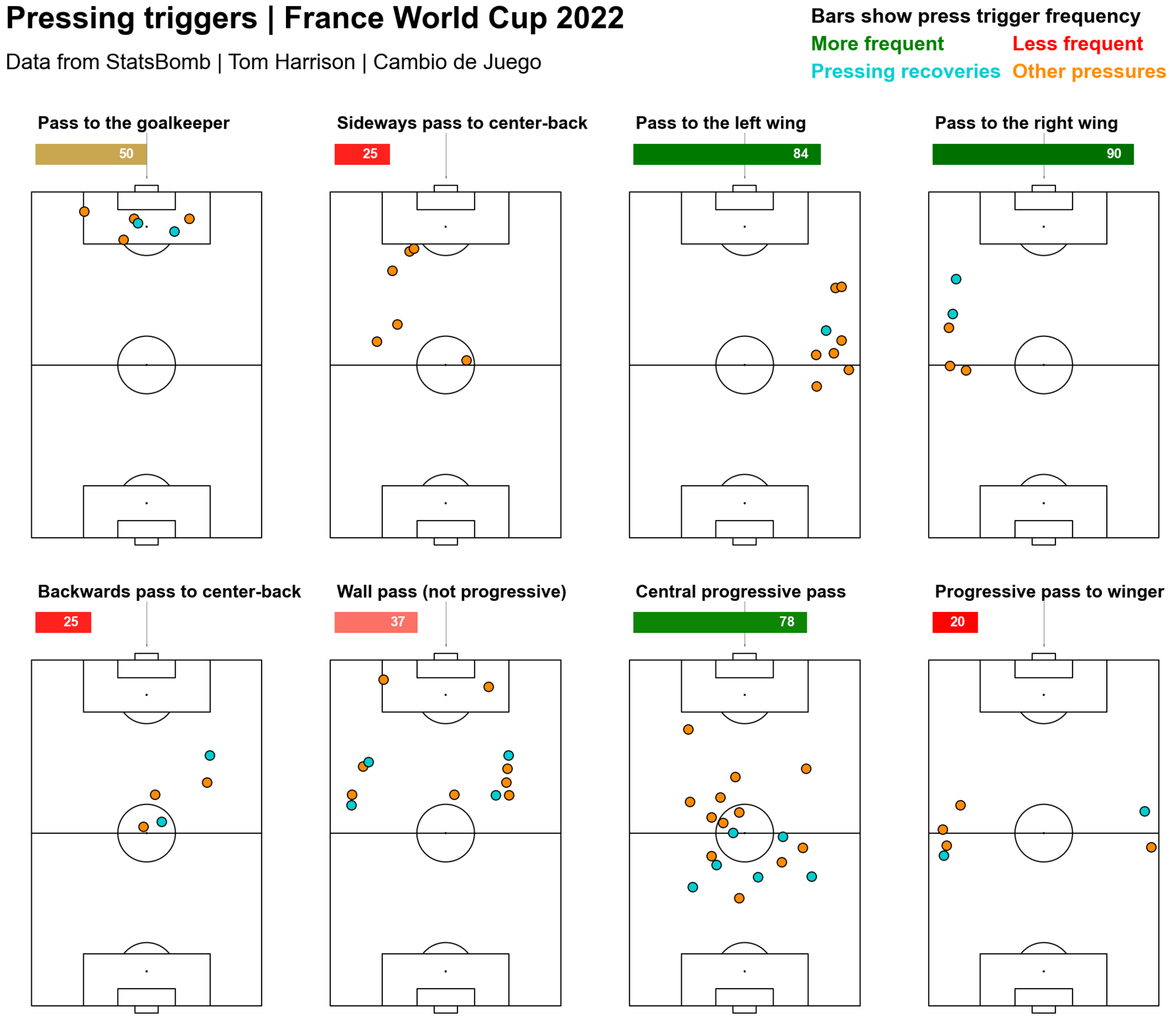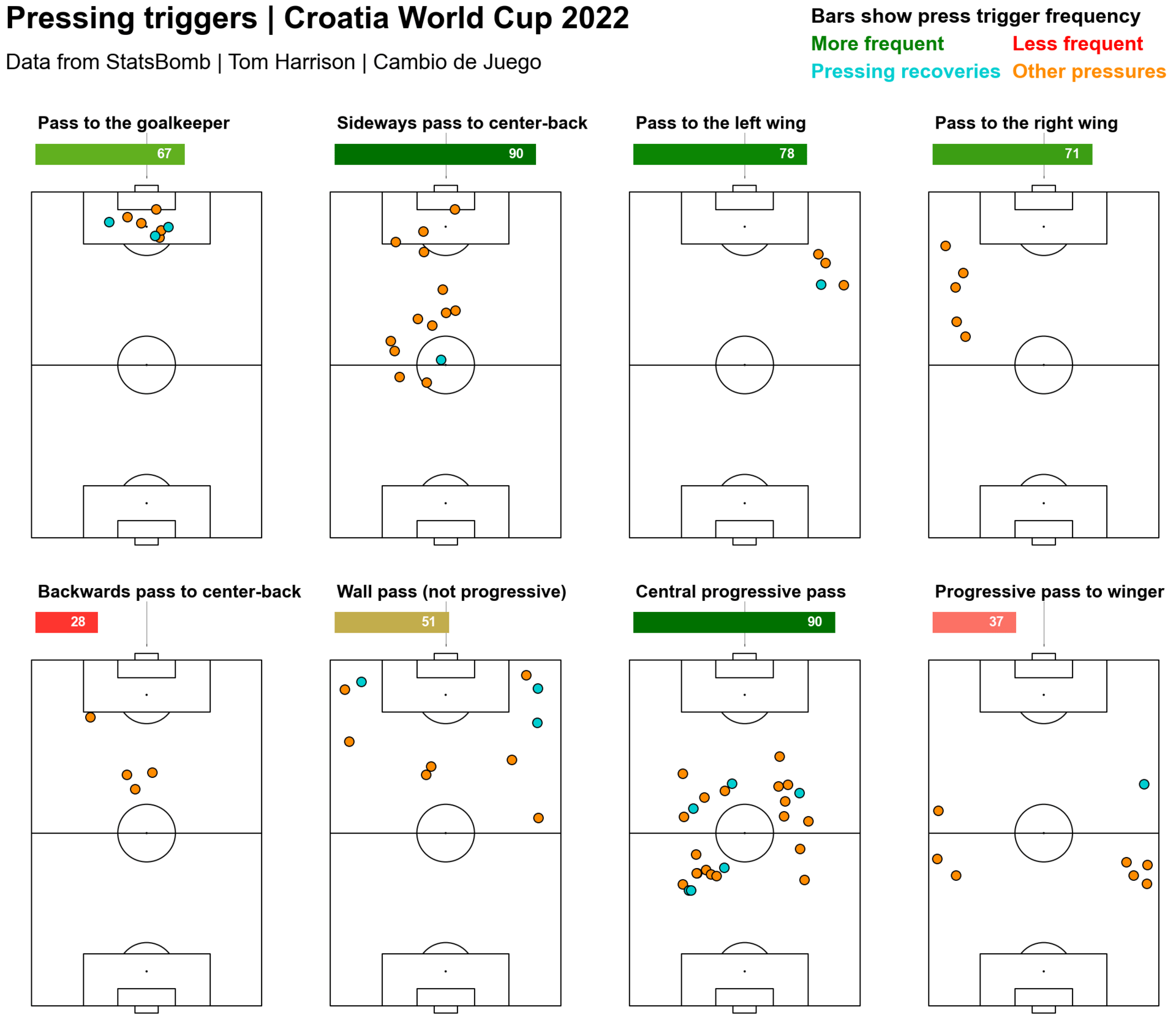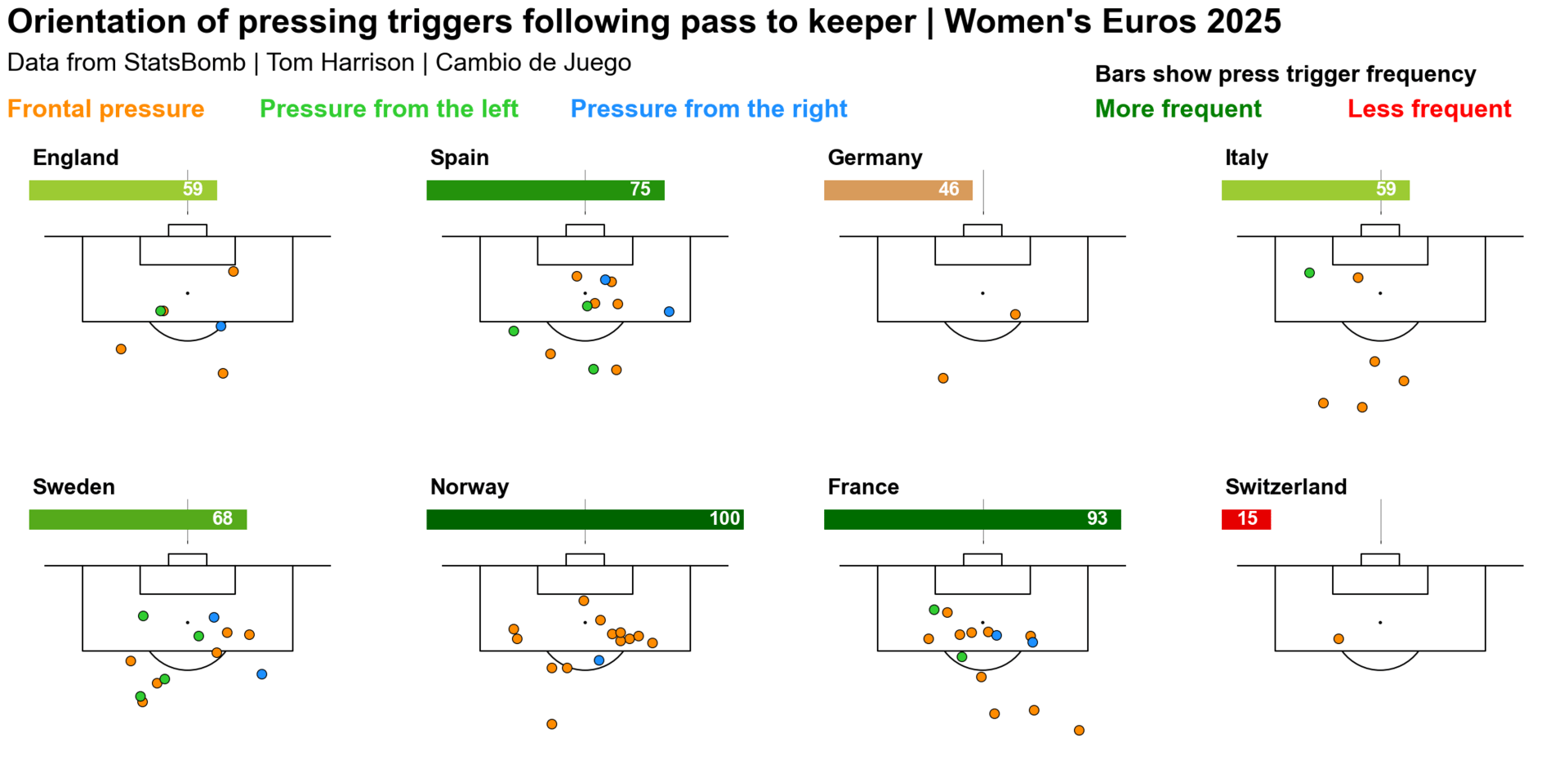- Cambio de Juego (In English)
- Posts
- Pressing triggers, orientation & defensive positioning
Pressing triggers, orientation & defensive positioning
Developing opposition analysis ideas & analyzing how pressing triggers impact outcomes
Data from StatsBomb, photo from Esquire Mexico.
Summary:
By focusing on the pass before the first pressing action in a sequence, it’s possible to analyze pressing triggers and trends.
Pressing triggers can impact the effectiveness of the strategy, for example, jumping onto a goalkeeper leads to more opposition ball progression.
Methods can be developed to analyze pressing orientation, defensive positioning in these situations, and passes after pressing triggers, to improve opposition analysis and match preparation in training.
Pressing triggers form an important part of an opposition analysis. Whilst pressing situations, overall, can be more influenced by general principles than specific instructions, the first action in a collective press is something that can be highly controlled and prepared for.
At times, the opposition can trigger the start of a press, with an error such as loose ball control, a mis-placed pass or poor body shape. However, some coaches will attempt to control these situations, and work on specific triggers to jump and start a press.
This article will explore different pressing triggers, by analyzing the pass that precedes the first pressing action in a possession sequence. I only took into consideration pressures that occurred within three seconds of the reception of the analyzed pass, and removed pressures in the defensive third.
The table below shows a description of the eight types of pressing triggers that I’ve defined:
Trigger | Definition |
|---|---|
Pass to the keeper | Any pass to the goalkeeper, that ends in the opponent’s defensive third |
Sideways pass to center-back | Any player making a sideways pass towards a center-back |
Pass to the left wing | Passes that begin in the center of the pitch, end on the left wing, and aren’t progressive |
Pass to the right wing | Passes that begin in the center of the pitch, end on the right wing, and aren’t progressive |
Backwards pass to center-back | Any backwards pass to a center-back |
Wall pass (non-progressive) | The second pass in a one-two combination (or wall pass), removing combos that move the ball forwards |
Central progressive pass | A progressive pass in the center of the pitch |
Progressive pass to winger | A progressive pass towards a winger, positioned on either flank |
Here are some visualization examples from the 2022 World Cup. The bars show how frequently the team used this pressing trigger vs other sides in the competition (normalised for opportunity). Green = More pressures. Red = Fewer pressures.
Each point shows the pressure locations, with the colour specifying whether or not there was a ball recovery in the following six seconds.
France didn’t show much intensity to press opposition center-backs, normally waiting for a pass out wide, or a progressive central pass, before triggering a press. This information could help a coach to prepare their pre-match training, for example, by constraining the shadow, or “B” team, by not allowing them to press the center-backs.

Croatia showed more of a willingness to jump onto a center-back, particularly when their opponent made a sideways pass. However, Croatia didn’t often step-up to jump on backwards passes to center-backs.

Meanwhile, England focused on backwards passes as their pressing trigger, especially when the opponent returned to a center-back. England also generated a good number of ball recoveries after jumping onto a goalkeeper.

Pressing trigger efficiency
The next table attempts to analyze the efficiency of each pressing trigger; ball recoveries and opposition progression in the six seconds following the pressure.
Trigger | Press recoveries (%) | Progression post-pressure (%) |
|---|---|---|
Pass to the keeper | 23.1% | 35.9% |
Sideways pass to center-back | 20.7% | 29.0% |
Pass to the left wing | 20.6% | 19.5% |
Pass to the right wing | 23.4% | 24.3% |
Backwards pass to center-back | 14.2% | 19.1% |
Wall pass (non-progressive) | 20.3% | 22.1% |
Central progressive pass | 28.9% | 11.1% |
Progressive pass to winger | 25.1% | 9.3% |
Jumping onto a goalkeeper to start a press is risky. More than 35% of these situations lead to opposition progression, with pressure on a goalkeeper inevitably resulting in an outfield player becoming unmarked.
Isolating just sideways and backwards passes, jumping out wide seems more efficient, considering the differences between recoveries and ball progression in the following six seconds. In theory, pressing out wide is easier, as the sideline acts as an extra defender. This analysis backs-up the theory behind the strategy, although it’s important to consider that central recoveries can create more dangerous transitions.
Jumping onto non-progressive wall passes can also be an effective strategy, more so than sideways or other backwards passes to a center-back.
John Muller explained the concept of jumping onto wall passes in this article:
As expected, with progressive passes often moving the ball into more congested areas, these actions result in more recoveries.
Pressing orientation
Some teams attempt to “split” into two horizontal halves by orienting the press and blocking passing lanes towards one side of the pitch. This helps reduce the space that a pressing team has to cover and control, and is a method of marking all realistic passing options, whilst maintaining a +1 in the defensive line.
However, there are coaches that prefer direct, frontal pressure on the ball carrier, to reduce the amount of time required to reach their opponent.
As I showed in a recent study, time required to generate pressure is an important concept in determining the efficiency of a pressing situation:
I’ve categorized different types of pressure, depending on the orientation.
Whilst it’s possible to generate approximations with StatsBomb’s standard events, 360 is needed for total accuracy. Therefore, I’ve created an example using 360 data from the 2025 Women’s Euros.
I took into account the angle between the player pressing and the goalkeeper, in order to see the orientation.

This graphic takes a look at the nations that made to, at least, the quarter-finals.

Norway, the most frequent side to trigger their press after a pass to the goalkeeper, almost always preferred direct, frontal pressure. Sweden and Spain more frequently pressed from one side.
With video analysis, or by visualizing player positioning with 360 data, it’s possible to understand defensive organisation in these specific situations.
For example, we can see how Sweden closely marked opponents in the center of the pitch when they oriented goalkeeper pressure from the left or right. However, they left sideways passing options on a few occasions.

Passes following a pressing trigger
Finally, I want to visualize how pressing triggers impact opposition decision making, and the most frequent types of passes selected.
I’ve created pass “clusters”, which group together similar passes based on their location, angle and destination. Afterwards, I calculated the five most common pass clusters, following each pressing trigger, and what the average pass, per cluster, looks like.
The following graphic shows the results.

Goalkeepers show a preference to pass towards the right under pressure, likely as it’s an easier pass to make for a right-footer. The most frequent pass are long, or look for a center-back or full-back.
Following sideways passes, it’s more common for the right center-back than the left center-back to be put under pressure, impacting the next pass in the possession. Out wide, the most common passes are backwards or forwards down the line. Diagonal forward passes, back towards the center, are rarer.
Pressing a center-back after a backwards pass normally results in a another backwards pass to the goalkeeper, or out wide, looking for a full-back. Finally, the majority of passes post-progression are short connections, often backwards, looking a teammate that faces the opposition goal.
This analysis, alongside the study of pressing trigger efficiency, can help coaches when designing a game model or specific match tactics.
The ideas and visualizations developed in this article could be used to add detail to an opposition or performance analysis report, backing-up the video report and helping traditional analysts and coaches to quickly find stylistic trends, prepare solutions and design specific training sessions.
Thank you for reading, if you’d like to contact me regarding any questions, comments or to consult my services, you can contact me on:
Linkedin - https://www.linkedin.com/in/thomas-harrison-a682a2175/
Twitter/X - https://x.com/tomh_36
También, se puede leer este artículo en Español- https://cambiodejuego.beehiiv.com/

